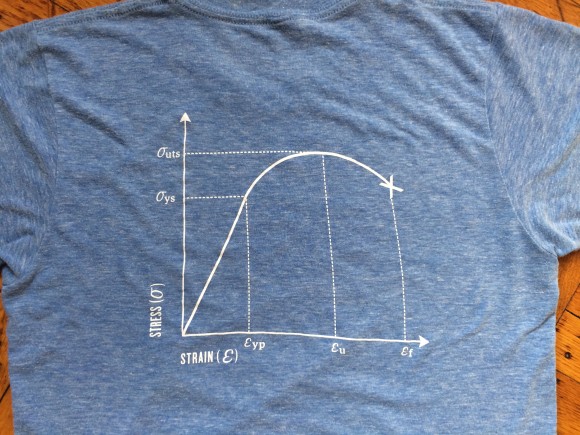This is a photo of the backside of the T-shirt for the operations engineering team at Etsy:
This diagram might not come as a surprise to those who know that I come from a mechanical engineering background. But I also wanted to have this on the T-shirt as a reminder (maybe just to myself, but hopefully those on the team) that organizations (or groups within them) can experience stresses and strains just like materials do.
About the time that I was thinking about the T-shirt I had come across “Stress-Strain Plots As a Basis For Assessing System Resilience” (Woods, D. D., & Wreathall, J. (2008))
One of the largest questions in my mind then (well, even before then, since then, and still) was: how to do engineers (in their particular environment and familiarity with their tools) allow for them to adapt and learn? If I could explore that question, then I might have some hope to answer, in the words of Eduardo Salas: “How can you turn a team of experts into an expert team?” (link)
In the paper, Woods and Wreathall explore the idea of the very familiar stress strain diagram that is found in the textbook of any materials science class for the last 10 decades or so. They look to this is an analogy for organizations and as illustrations that groups of people organizations have different “state spaces” in which they adapt.
In “uniform” or normal stretching there is what they would describe as the competence envelope and then past that, there are the more interesting “extra regions” were teams have to reconfigure, improvise, and make trade-offs in uncertain conditions. This topic is so interesting to me I decided to do a master’s thesis on it.
Here’s the thing: no work in complex systems can be prescribed. Which means it can’t be codified, and it can’t be proceduralized. Instead, rules and procedures and code are the scaffolding upon which operators, designers, engineers adapt, in order to be successful.
Sometimes these adaptations bring efficiencies. Sometimes they bring costs. Sometimes they bring surprises. Sometimes they bring more needs to adapt. But one thing is certain: they don’t bring the system back to some well-known equilibrium of ‘stable’ – complex systems don’t work that way.
But you don’t have to read my interpretation of the paper, you should just go and read it. 🙂
The last (and potentially just as important) reminder for me in the diagram is that all analogies have limits, and this one is no exception. When we use analogies and don’t acknowledge their limitations we can get into trouble. But that’s for a different post on a different day.


This is hidden behind a ResearchGate paywall that demands we prove association and membership in a supporting organization to gain access.
In short, your paper is not available to the very people you are describing and to whom you are promoting this paper.
Jo Rhett: oops! Sorry about that. Link fixed now.
The link is broken again 🙁
Jo Rhett: fixed various links again. Unfortunately, the Academic Industrial Complexâ„¢ makes it difficult to share these consistently. :/